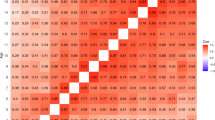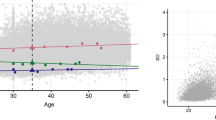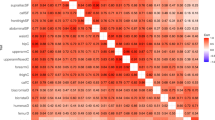Abstract
OBJECTIVES:
Twin and adoption studies suggest that family environment has little, if any, influence on body mass index (BMI) in adulthood. We investigated the hypothesis that the differences in the years of birth between siblings influence their similarity in BMI at comparable ages, which would give evidence for a possibly modifiable influence of the environment shared by family members.
METHODS:
Swedish full-brother pairs (N=261 712) born between 1951 and 1983 were measured for BMI in conscription examination at 16–26 years (median: 18.2 years) of age and were divided into quartiles by the difference between their birth-years (< 2.25 years, 2.25–3.33 years, 3.34–5.08 years and >5.08 years). Furthermore, 1961 dizygotic twin brother pairs from the same population representing brothers born at the same time were included. In addition, the log BMI of the younger brother was modeled as a linear function of the log BMI of the older brother. Subsequently, the significance of the interaction between birth-year difference and the BMI of the older brother was tested.
RESULTS:
Intraclass correlation for BMI in dizygotic twin pairs was higher (0.431, 95% confidence interval (CI) 0.394–0.466) than the correlation for full-brothers in the first quartile of birth-year difference (0.376, CI 0.342–0.408). Among full-brothers, the BMI correlation decreased from 0.378 (CI 0.372–0.385) in the first quartile to 0.338 (CI 0.331–0.345) in the last quartile. The regression analysis showed a statistically significant decrease in correlation with increasing birth-year difference (P<0.001).
CONCLUSION:
The influence on BMI in young men of the environment shared by dizygotic twin brothers is greater than between non-twin full-brothers, indicating important influences of concomitant exposure to the same early life environment before and/or after birth. Among non-twin siblings there is a slight possibly modifiable influence as evidenced by declining correlations by increasing distance in years of birth.
This is a preview of subscription content, access via your institution
Access options
Subscribe to this journal
Receive 12 print issues and online access
$259.00 per year
only $21.58 per issue
Buy this article
- Purchase on Springer Link
- Instant access to full article PDF
Prices may be subject to local taxes which are calculated during checkout

Similar content being viewed by others
References
Ford ES, Mokdad AH . Epidemiology of obesity in the Western Hemisphere. J Clin Endocrinol Metab 2008; 93 (Suppl 1): S1–S8.
Ogden CL, Yanovski SZ, Carroll MD, Flegal KM . The epidemiology of obesity. Gastroenterology 2007; 132: 2087–2102.
World Health Organization. Global Strategy on Diet, Physical Activity and Health, 2011, 8 February 2011.
Herman KM, Craig CL, Gauvin L, Katzmarzyk PT . Tracking of obesity and physical activity from childhood to adulthood: the Physical Activity Longitudinal Study. Int J Pediatr Obes 2009; 4: 281–288.
Maes HH, Neale MC, Eaves LJ . Genetic and environmental factors in relative body weight and human adiposity. Behav Genet 1997; 27: 325–351.
Neale MC, Maes HHM . Methodology for Genetic Studies of Twins and Families. Kluwer Academic Publishers B.V.: Dordrecht, The Netherlands, 2006.
Silventoinen K, Rokholm B, Kaprio J, Sørensen TIA . The genetic and environmental influences on childhood obesity: a systematic review of twin and adoption studies. Int J Obes (Lond) 2010; 34: 29–40.
Schousboe K, Willemsen G, Kyvik KO, Mortensen J, Boomsma DI, Cornes BK et al. Sex differences in heritability of BMI: a comparative study of results from twin studies in eight countries. Twin Res 2003; 6: 409–421.
Keller MC . Coventry WL. Quantifying and addressing parameter indeterminacy in the classical twin design. Twin Res Hum Genet 2005; 8: 201–213.
Sørensen TIA, Stunkard AJ . Overview of adoption studies. In: Bouchard C, (ed) The Genetics of Obesity. CRC Press: Boca Raton, FL, USA, 2004, pp 49–62.
Sørensen TIA, Holst C, Stunkard AJ . Childhood body mass index--genetic and familial environmental influences assessed in a longitudinal adoption study. Int J Obes Relat Metab Disord 1992; 16: 705–714.
Sørensen TIA, Rasmussen F, Magnusson PK . Adoption studies. In: Clément K, Sørensen TIA, (eds). Obesity: Genomics and Postgenomics. Informa Healthcare: New York, NY, USA, 2008, pp 29–38.
Lichtenstein P, De FU, Floderus B, Svartengren M, Svedberg P, Pedersen NL . The Swedish Twin Registry: a unique resource for clinical, epidemiological and genetic studies. J Intern Med 2002; 252: 184–205.
Rasmussen F, Kark M, Tholin S, Karnehed N, Tynelius P . The Swedish Young Male Twins Study: a resource for longitudinal research on risk factors for obesity and cardiovascular diseases. Twin Res Hum Genet 2006; 9: 883–889.
Sykes B, Irven C . Surnames and the Y chromosome. Am J Hum Genet 2000; 66: 1417–1419.
Christiansen L, Frederiksen H, Schousboe K, Skytthe A, von Wurmb-Schwark N, Christensen K et al. Age- and sex-differences in the validity of questionnaire-based zygosity in twins. Twin Res 2003; 6: 275–278.
Silventoinen K, Pietilainen KH, Tynelius P, Sorensen TI, Kaprio J, Rasmussen F . Genetic and environmental factors in relative weight from birth to age 18: the Swedish young male twins study. Int J Obes (Lond) 2007; 31: 615–621.
Silventoinen K, Magnusson PK, Tynelius P, Kaprio J, Rasmussen F . Heritability of body size and muscle strength in young adulthood: a study of one million Swedish men. Genet Epidemiol 2008; 32: 341–349.
Acknowledgements
This project was funded by the Danish Agency for Science, Technology and Innovation (http://en.fi.dk/). We are grateful to the Swedish Twin Register for giving us access to information on zygosity of the twins. The work is part of the research in the Danish Obesity Research Centre (www.danorc.dk).
Author information
Authors and Affiliations
Corresponding author
Ethics declarations
Competing interests
The authors declare no conflict of interest.
Rights and permissions
About this article
Cite this article
Rokholm, B., Silventoinen, K., Tynelius, P. et al. Modifiable environmental influences on body mass index shared by young adult brothers. Int J Obes 37, 211–215 (2013). https://doi.org/10.1038/ijo.2012.151
Received:
Revised:
Accepted:
Published:
Issue Date:
DOI: https://doi.org/10.1038/ijo.2012.151



